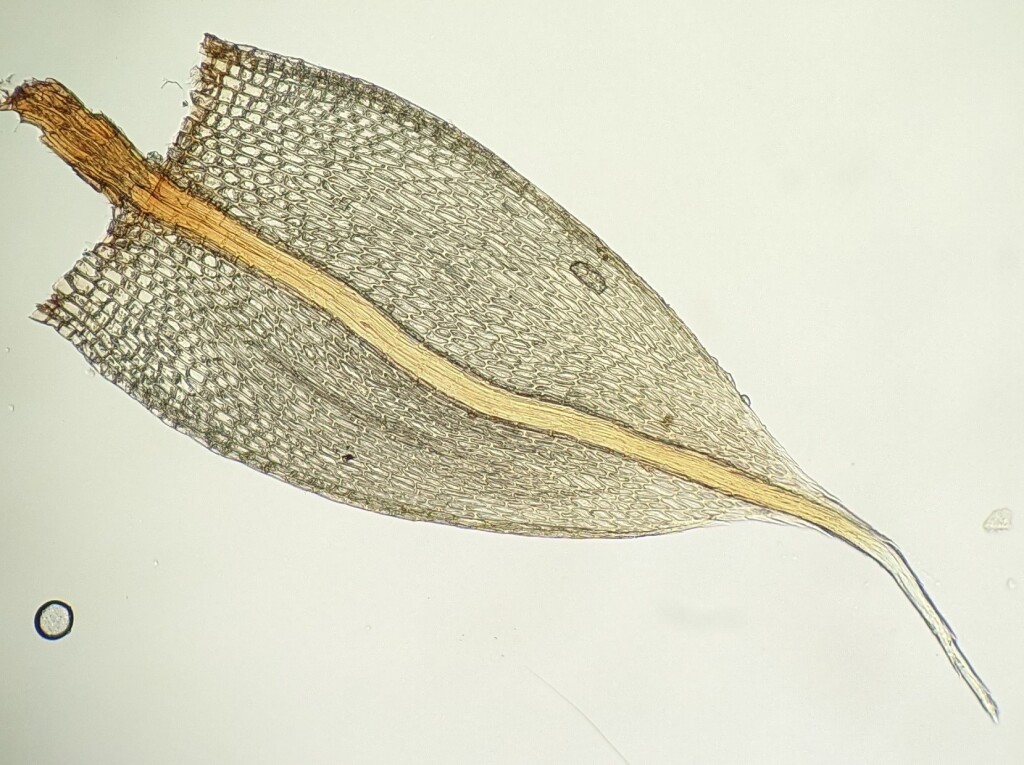Bryum
Dioicous or rarely synoicous. Asexual reproduction by bulbils in leaf axils or by tubers on stem or rhizoids. Tufts, turves or cushions on soil or rocks. Stem simple or branched by innovation, with sparse rhizoids or tomentose; central strand present. Leaves ovate or elliptic to lanceolate, crowded, imbricate, erect to erect-spreading when moist or dry, sometimes becoming contorted when dry; apex obtuse, apiculate, acute or acuminate, sometimes with a hairpoint; costa terminating in apical half, percurrent or excurrent; margin entire to serrulate, plane or revolute, with or without a border of narrower cells; laminal cells rhomboid or hexagonal to linear-vermicular, becoming wider and abruptly oblate or quadrate to short-rectangular near base, smooth; alar cells not differentiated. Capsules erect to pendent, ovoid to cylindric or obovoid, with a revoluble annulus. Calyptra cucullate, smooth, glabrous. Operculum conic or hemispheric, apiculate. Peristome double; endostome segments similar height as exostome teeth or reduced, with a high or low basal membrane, or endostome absent (not in Victoria); cilia present and well-developed or reduced, or absent.
Worldwide with around 150 species; 19 species in Victoria.
The majority of Gemmabryum species are closely related to Bryum, including its type, G. pachythecum (Müll.Hal.) J.R.Spence & H.P.Ramsay, according to phylogenetic analyses of chloroplast DNA sequences (Cox & Hedderson 2003; Pedersen & Hedenäs 2003, 2005), and Gemmabryum is included here within Bryum. A few species of Gemmabryum are placed outside this expanded Bryum lineage, close to Ptychostomum, demonstrating convergent evolution of small gametophyte size and asexual reproduction by rhizoidal tubers to enable colonisation of unstable soil habitats (Holyoak & Pedersen 2007). This obscures morphological differentiation with Ptychostomum and it is unclear whether the two groups have unique morphological features that can allow their differentiation based on the current extent of research and species sampling in phylogenetic studies. While not restricted to Bryum in its broad circumscription here, in general Bryum are defined by laminal cells that are narrowly elongate, becoming abruptly broader and short-rectangular or quadrate near the base (need to check Spence 1987 for Anomobryum group however, Anomobryum not in this expanded Bryum). Spence & Ramsay (2013) transferred some of the Australian species included in Bryum here to Imbribryum. One of the transferred species had been shown in chloroplast DNA phylogenies to belong to what is here recognised as Bryum, rather than the type of Imbribryum (Pedersen & Hedenäs 2003), and so these changes are not followed here.
 Spinning
SpinningSynonyms
Cox, C.J.; Hedderson, T.A.J. (2003). Phylogenetic relationships within the moss family Bryaceae based on chloroplast DNA evidence. Journal of Bryology 25: 31–40.
Holyoak, D.T.; Pedersen, N. (2007). Conflicting molecular and morphological evidence of evolution within the Bryaceae (Bryopsida) and its implications for generic taxonomy. Journal of Bryology 29: 111–124.
Pedersen, N.; Hedenäs, L. (2003). Phylogenetic investigations of a well supported clade within the acrocarpous moss family Bryaceae: evidence from seven chloroplast DNA sequences and morphology. * Plant Systematics and Evolution* 240: 115–132.
Pedersen, N.; Hedenäs, L. (2005). Taxonomic and nomenclatural implications of phylogenetic studies of the Bryaceae based on molecular data and morphology. The Bryologist 108: 123–128.
Spence, J.R. (1987). A proposed reclassification of Bryum, Anomobryum and Brachymenium (Musci, Bryaceae). Journal of Bryology 14: 659–676.
Spence, J.R.; Ramsay, H.P. (2013). Additions to and nomenclatural changes in the Bryaceae (Bryopsida) in Australia. Telopea 15: 143–148.




